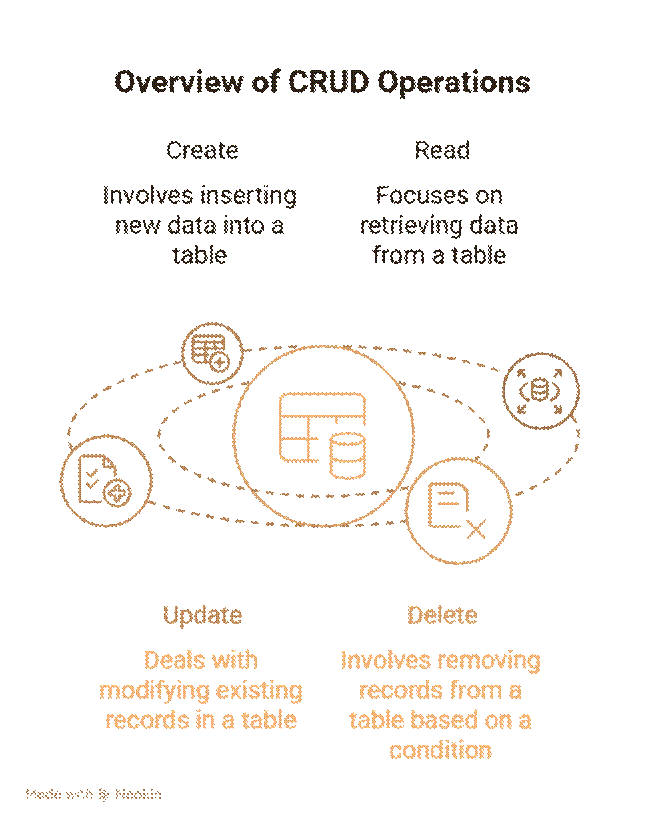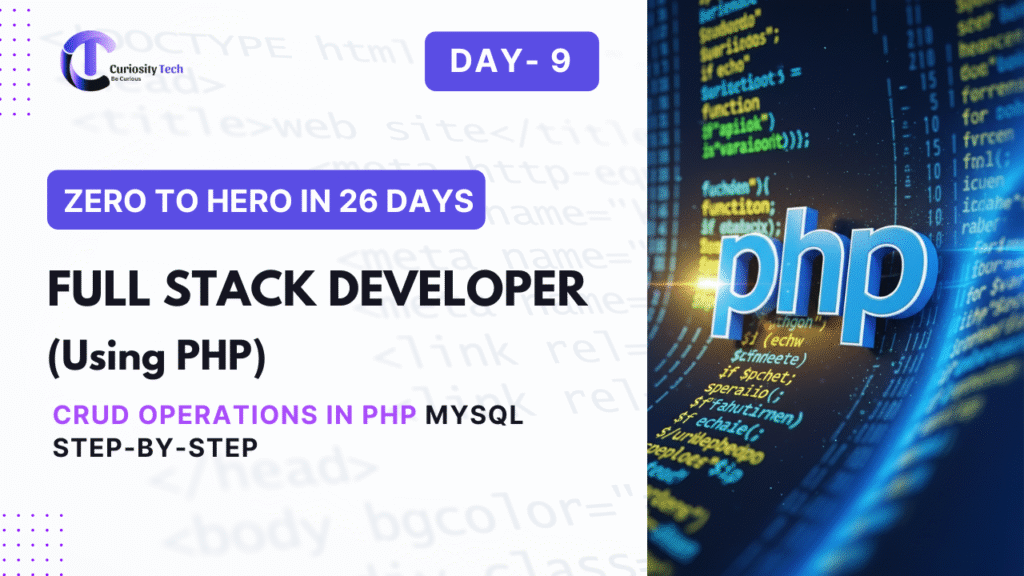Introduction
On Day 9, we move forward from database integration to CRUD operations in PHP with MySQL. CRUD stands for Create, Read, Update, and Delete — the fundamental operations that allow a web application to manage data dynamically.
At CuriosityTech.in, learners not only understand the theory but implement real-world CRUD systems, such as user management dashboards, product catalogs, and content management systems, ensuring hands-on experience in Full Stack development.
1. Setting Up the Database Table
Before performing CRUD operations, you need a MySQL table. For example, a users table:
CREATE TABLE users (
id INT AUTO_INCREMENT PRIMARY KEY,
name VARCHAR(100) NOT NULL,
email VARCHAR(100) UNIQUE NOT NULL,
created_at TIMESTAMP DEFAULT CURRENT_TIMESTAMP
);
Table Structure:
| Column | Data Type | Constraint |
| id | INT | PRIMARY KEY, AUTO_INCREMENT |
| name | VARCHAR(100) | NOT NULL |
| VARCHAR(100) | UNIQUE, NOT NULL | |
| created_at | TIMESTAMP | DEFAULT CURRENT_TIMESTAMP |
2. Create – Inserting Data
Using PDO for secure data insertion:
<?php
$name = “Bhavesh Barange”;
$email = “bhavesh@curiositytech.in”;
$stmt = $pdo->prepare(“INSERT INTO users (name, email) VALUES (:name, :email)”);
$stmt->bindParam(‘:name’, $name);
$stmt->bindParam(‘:email’, $email);
$stmt->execute();
echo “User added successfully!”;
?>
Tip: Always use prepared statements to prevent SQL injection.
3. Read – Retrieving Data
Fetching data allows you to display database records dynamically:
<?php
$stmt = $pdo->query(“SELECT id, name, email FROM users”);
echo “<table border=’1′>
<tr><th>ID</th><th>Name</th><th>Email</th></tr>”;
while($row = $stmt->fetch(PDO::FETCH_ASSOC)) {
echo “<tr>
<td>{$row[‘id’]}</td>
<td>{$row[‘name’]}</td>
<td>{$row[’email’]}</td>
</tr>”;
}
echo “</table>”;
?>
Output:
A dynamic HTML table showing all users in the database.
4. Update – Modifying Records
Updating records is crucial for managing user data:
<?php
$id = 1;
$newName = “Bhavesh Updated”;
$stmt = $pdo->prepare(“UPDATE users SET name = :name WHERE id = :id”);
$stmt->bindParam(‘:name’, $newName);
$stmt->bindParam(‘:id’, $id);
$stmt->execute();
echo “User updated successfully!”;
?>
Key Points:
- Always validate user input before updating records.
- Use unique identifiers (like id) to ensure precise updates.
5. Delete – Removing Records
Deleting records permanently from the database:
<?php
$id = 1;
$stmt = $pdo->prepare(“DELETE FROM users WHERE id = :id”);
$stmt->bindParam(‘:id’, $id);
$stmt->execute();
echo “User deleted successfully!”;
?>
Security Tip:
- Confirm deletion actions with users to avoid accidental data loss.
- Use prepared statements to prevent malicious queries.
6. CRUD Hierarchy Diagram

7. Best Practices for CRUD in PHP
| Practice | Recommendation |
| Security | Use prepared statements (PDO/MySQLi) |
| Validation | Always validate user input before DB operations |
| Error Handling | Catch exceptions and log errors |
| Modularity | Use functions or classes for repeated CRUD logic |
| User Experience | Provide confirmation messages for update/delete actions |
8. CuriosityTech.in Perspective
At CuriosityTech.in, students practice CRUD operations on real projects like contact forms, online stores, and content management systems. By combining PHP core skills (Day 6), secure form handling (Day 7), and database integration (Day 8), learners gain the ability to build dynamic, functional, and secure full-stack applications ready for production.
Conclusion
CRUD operations form the backbone of any dynamic web application. Mastering Create, Read, Update, and Delete in PHP with MySQL allows developers to manage data effectively, implement complex business logic, and ensure application scalability. Today’s skills are the foundation for authentication and session management in Day 10.



